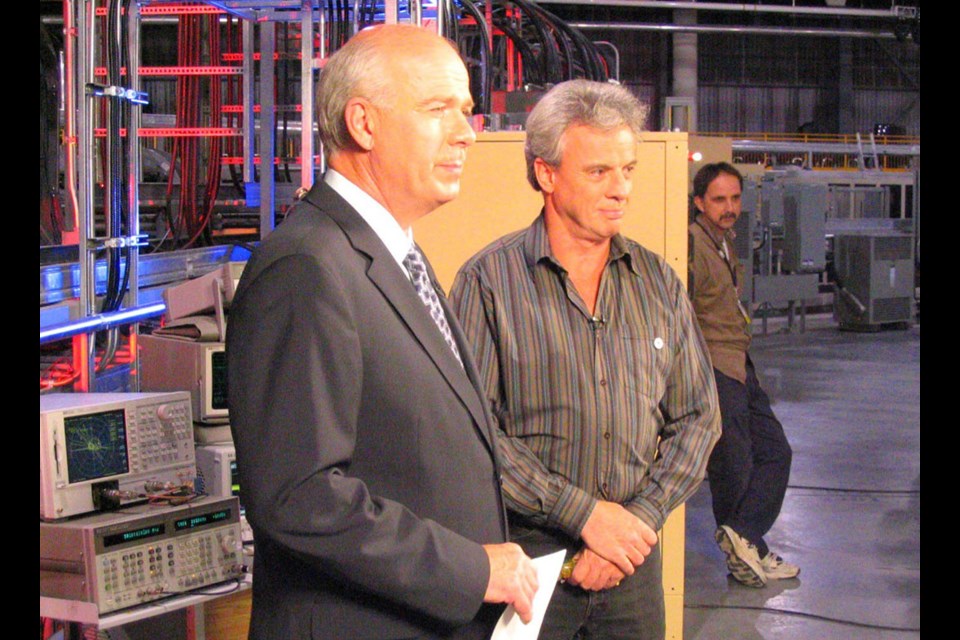SASKATOON — Twenty years ago this fall, CBC’s Peter Mansbridge hosted The National from the centre of USask’s huge synchrotron experimental hall to mark the impending launch of the nation’s largest science project in a generation—the Canadian Light Source (CLS).
“Tonight, Field of Beams,” Mansbridge began. “A Canadian first. Scientists turn a piece of prairie into a world-class super microscope.”
A “microscope” in the sense that by producing light millions of times brighter than the sun from the energy of electrons racing around an enormous ring at nearly the speed of light. As a result, the synchrotron enables scientists to use this intensely bright light to “see” the microscopic nature of matter—whether in metals, plants, fabrics or human cells—right down to the level of atoms.
Bob McDonald, host of a CBC Quirks and Quarks radio show on the CLS launch, predicted that there’d be “things done here people have not even thought about yet.” He was certainly right about that.
Today, more than 1,000 academic, government and industrial scientists use the CLS beamlines to shed light on a wide variety of scientific and medical challenges. These include improving drug delivery in patients, finding vaccines against gastric cancer or pig diseases, developing a way to convert patient blood types into the universally useful O-negative, discovering new materials for electronic devices, finding ways to turn mine waste into healthy soil, and using pulp and paper waste to scrub carbon from emissions.
Building the CLS, a dream of scientists for decades, catapulted USask into the big leagues of scientific research. The 20th anniversary will be celebrated during this 2024/2025 academic year.
How did USask become home to Canada’s only synchrotron? The answer in large part is that the university would not have been awarded the synchrotron by an international scientific panel were it not for the strong foundation of expertise and facilities we’d already built.
The unique-in-Canada spectroscopy lab set up in the 1930s by Dr. Gerhard Herzberg (PhD), who used light spectra to figure out the structure of molecules and went on to win the Nobel Prize in 1971, was an important first step in developing excellence in radiation chemistry. Other key steps led to USask’s highly regarded nuclear and accelerator physics expertise including:
- USask physicist Ertle Harrington (PhD) used high-energy gamma rays to provide Saskatchewan cancer clinics with radon for cancer radiotherapy (1931 to 1962);
- Canada’s first betatron high-energy accelerator for radiation therapy and research was purchased in the late 1940s by USask electron accelerator expert Dr. Leon Katz (PhD) and Dr. Harold Johns (PhD), who in 1951 was responsible, along with Dr. Sylvia Fedoruk (PhD), for the USask medical breakthrough of using cobalt-60 radiation to successfully treat a cancer patient;
- With the help of USask math professor Dr. Roger Servranckx (PhD), a globally recognized expert on electron ring designs, Katz led construction of the linear accelerator—or “linac”—which was completed in 1964, attracting researchers from around the world.
Already a national leader in particle physics, USask was able to contribute its existing multi-million-dollar linear accelerator to the CLS project. Given the $173.5-million CLS construction cost, this was an important advantage, along with the remarkable $2.4-million contribution from the City of Saskatoon and the $27 million from the Saskatchewan government and SaskPower. While USask put up $7.3 million as the facility owner, 18 other universities endorsed the project and two of them put up $300,000 each. The result was unprecedented funding for a Canadian science project from government at all levels, universities and industry.
Not surprisingly, science using synchrotron experiments is a signature area of USask research and a huge advantage for USask researchers and students. For instance, a new composite ceramic glass material shows promise for safer storage of nuclear waste, canola meal pellets could potentially be used to heat homes, and research into phosphorus use in soil is helping farmers in Nigeria and the Republic of Benin grow vegetables less expensively and more sustainably with less fertilizer.
The CLS has a significant impact on the local and national economy. Every $1 invested in the CLS is effectively doubled in terms of national GDP impact.
Earlier this year, the 60-year-old CLS linear accelerator was dismantled and replaced with an updated one that will soon be brought online. Given that synchrotron technologies are evolving, the national group of synchrotron users is currently conducting a review of what they and the global community will need from a Canadian synchrotron for the future.
As well, the Canada Foundation for Innovation is looking at developing a new funding model for major science facilities such as the CLS.
In the 2004 national broadcast, it was pointed out that there was no other university in Canada that stepped up the way USask did: “Where others wouldn’t, the University of Saskatchewan would.” Unique scientific expertise, unparalleled determination, and unprecedented collaboration brought the CLS to Saskatoon, and will continue to shape its future.
— Submitted by USask Media Relations




